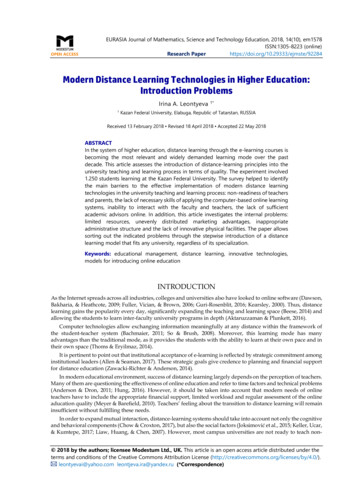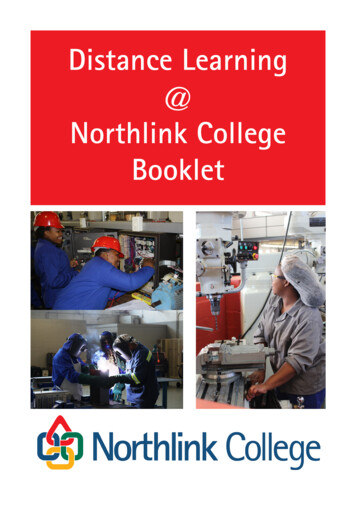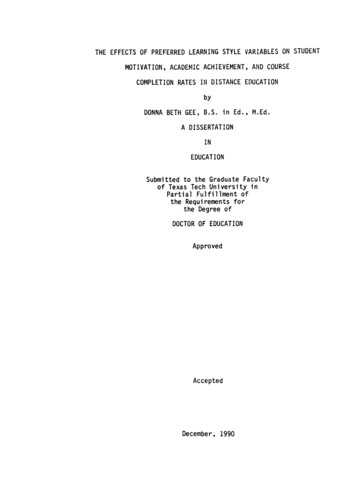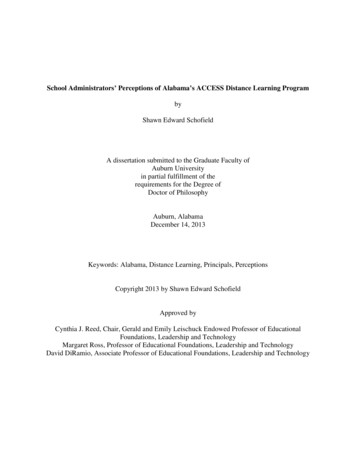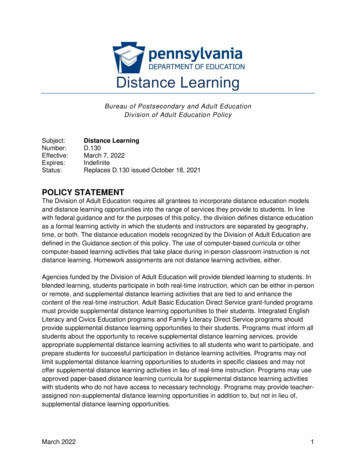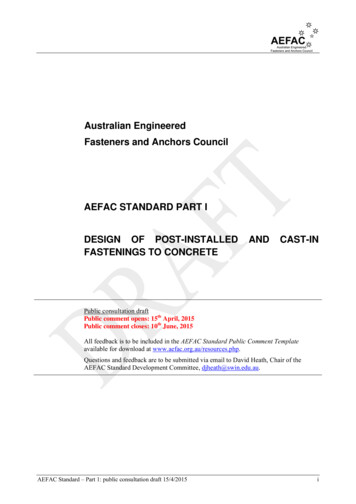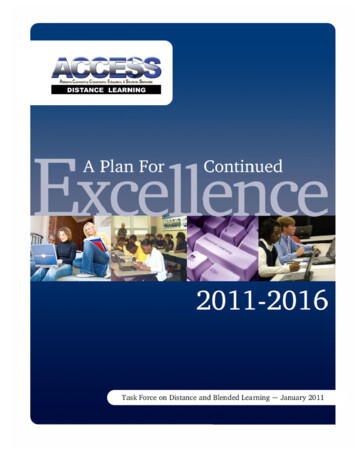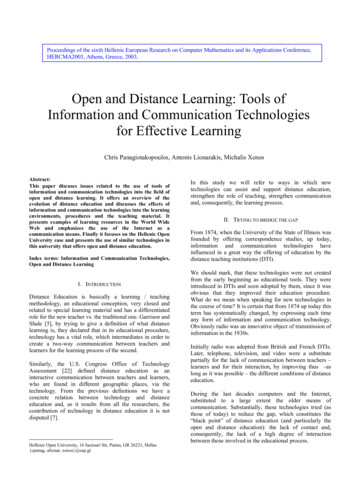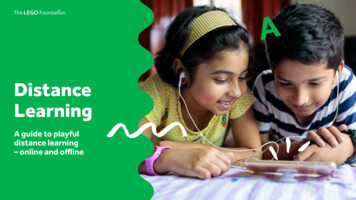
Transcription
ADistanceLearningA guide to playfuldistance learning– online and offline
The LEGO FoundationDistance Learning2IntroducingDistance LearningThe COVID-19 pandemic hasdisrupted the routines of children,their families and teachers acrossthe world. In any crisis thatdemands the physical closure ofschools, distance learning is thesafest and most feasible solution,helping children to continuelearning away from the classroom.Distance learning means any learning that happens at a physicaldistance. Distance from what? Not just from teachers. Withschool closures during the COVID pandemic, children have foundthemselves distant from things like:The safe spaces of school buildings and playgroundsSchool meals programmes Stimulating environments, with books and technology Interaction and play with their peers, and other social andemotional support Creative activities such as music, dance, theatre and games.
The LEGO FoundationDistance LearningAt the LEGO Foundation, webelieve that children learn bestthrough play. We therefore thinkof distance learning as much morethan just the packaging of learningcontent for remote delivery.3Distance learning should be abouthaving a flexible approach, aimed atchildren’s overall development. It needsto be sensitive to the great diversity inchildren’s circumstances, and especiallythe amount of access that children haveto learning resources.There are many forms of distancelearning: they use different kinds oftechnology, to different degrees. Usedwell, they all have the potential to connectchildren to teachers, and to each other,across physical distance.PLAYThe LEGO Foundation DistanceLearning Guide offers ideas, evidenceand links to useful resources andlearning communities, to help you makechildren’s distance learning moreplayful, engaging, joyful and effective,whether children are learning online oroffline.Many learnings from the pandemic canalso be applied in other crises.
The LEGO FoundationDistance Learning4Who is thisguide for?The LEGO Foundation has puttogether this practical guide foreveryone who is responsible forshaping children’s learning inthe context of school closures:especially teachers and otherhands-on educators, andeducation administrators anddecision-makers.Parents,teachers &educatorsSchooladministrators& principals
The LEGO FoundationDistance Learning5What thisguide contains?ABCWe suggest four thingsto consider with distancelearning, based on what worksin practice.We highlight various formsof distance learning – threeonline and five offline – eachwith their advantages andchallenges.We look at commonchallenges in distance learningaround the world, and makerecommendations to help youset up or develop a distancelearning programme.
The LEGO FoundationDistance LearningThings to consider withdistance learning6
The LEGO FoundationDistance LearningThings toconsider withdistance learningDrawing on evidence of distancelearning from around the world, wehave identified some importantthings to consider, to help makelearning inclusive, engaging,focused on and meaningful forchildren, joyful and sociable.701.Nurturing acommunityof learners03.Making learningflexible02.- Keepinglearners safeonline04.The Spectrumof Play
The LEGO Foundation01Distance Learning8Nurturing acommunity oflearnersThe shift to learning remotelystarts with creating a virtual homefor your learning community, andestablishing new routines. As youdo this, it is important to rememberthat not every family has the sameaccess to technology or digitalskills.The following stories show howsome teachers have workedto build a sense of communitywhile in lockdown.
The LEGO FoundationDistance Learning9C ASE STUDIE SNurturing acommunity oflearnersNAMELOC ATIONNAMELOC ATIONSarah FraserScotlandJessica DreyerDenmarkHot Chocolate FridaysSarah is the Headteacher of Newtonmore Primary School in Scotland.Since the school closed down in March 2020, Sarah and her staffteam have worked hard to adapt and support their pupils’ learningand well-being. One thing they did was host an informal online catchup with their classes every Friday. Children join the session with ahot chocolate or their favourite drink. Some weeks, children get towear their brightest jumper or a hat. This is an opportunity to end theschool week by coming together and having some fun, which bothparents and children appreciate.Friendship GroupsJessica knows that it can be difficult for the children in her class tomeet each other in big groups online. She therefore created a Doodlepoll where the children can sign up to meet their friends in smallergroups of four. After welcoming the children, Jessica steps back andlet them lead the gatherings. They usually show each other toys andsometimes get quite silly.
The LEGO FoundationDistance Learning10C ASE STUDIE SALLNurturing acommunity oflearnersNAMELOC ATIONNAMELOC ATIONAsmaa KhanSouth AfricaKim RipleyUnited StatesVirtual Pyjama PartiesAsmaa video calls her students daily in order to nurture her onlinelearners. This can be challenging with small children as they areinexperienced with video calls and feel shy. But when some of herstudents mentioned that they miss their friends, Asmaa set up apyjama party over Zoom. Some children remained shy, but othersstarted chatting to each other. Eventually she muted everyone, andallowed each child to show their favourite toy, speak about it, andshare a short message with their friends.AASinging RoutinesEvery Friday since the Hampshire College Early Learning Centerin Massachusetts closed down, Kim and her colleagues have beenholding a singalong on Zoom. But how are the teachers managingthis on an online format? At the weekly online staff meeting theteachers discuss what is working with their Zoom singing and whatto change, which songs seem particularly popular and how to handletricky issues such as call and response singing. They always startwith the same introductory song, and because of the slight timedelay on Zoom, they have learned to mute everyone (except thesong leader) most of the time.
The LEGO Foundation02Distance Learning11Keeping learnerssafe onlineAs children use online platformsfor distance learning, away fromthe classroom and with less adultsupervision, there are importantthings to bear in mind abouttheir safety: their privacy forexample, or their being exposed toinappropriate material.It is important to help equipchildren with the skills they need,to know what information they cantrust, to communicate with eachother respectfully, and to stay safeonline.Where to get adviceGlobal Kids Online. A toolkit from UNICEF,the London School of Economics and theEU Kids Online network.Common Sense Media. Practical resourcesfor parents and educators, to help childrenstay safe on the Web.
The LEGO Foundation03Distance Learning12Making learningflexibleSticking to routines can be difficultfor families in any crisis, anddifferences in family situationsand access to distance learningsessions require a flexible approachto teaching.On the following page two teachersdescribe how they have foundinspiring ways to support theirlearners to connect and learnflexibly.8
The LEGO FoundationDistance Learning13C ASE STUDIE SMaking learningflexibleNAMELOC ATIONNAMELOC ATIONJessica MontgomerySouth Africa / ChinaIdah KhanMozambiqueBe flexible with people, objects & spacesJessica is an experienced online educator, living in South Africa butteaching children in China, and she has a wealth of ideas when itcomes to flexible online teaching. One thing to remember is thatevery time the camera turns on a remote communication platform,you are entering someone’s private space and you never knowwhat you will find. There will be times when your students are aloneand times when they’re sharing the room with family members,times of calm, and times of mess. It makes life easier when oneincorporates the learner’s environment into the lesson, no matterif it concerns people or objects. Jessica points out that there tendsto be a high level of engagement when children get to use personaland meaningful objects as opposed to learning theoretically, andthat there are many cases when siblings enter the frame wanting toengage with you and the student. Here, it is always best to includethem in the lesson too.Create flexible STEM-like activitiesIdah is a teacher coach for the Primary Years Programme at theAga Khan Academy in Maputo, Mozambique. With the country inlockdown, Idah and her colleagues are striving to be as flexible withthe curriculum as possible. Because teaching at a distance is not thesame as teaching in person, Idah’s school is not ploughing ahead withlessons, teaching something just because they planned it. Insteadthey offer STEM-like activities where students can respond to achallenge by making a physical object (often in collaboration withfamily members), getting feedback from teachers and classmates,and then making changes to their creations. While the internet is filledwith such ideas, Idah is making sure these activities are adapted to fitthe realities in homes where ‘taken for granted’ resources may not beavailable. For example, rather than saying ‘make a drum from a can’ thechallenge becomes to ‘use something at home to make a rhythm’.
The LEGO FoundationDistance Learning14The spectrumof play facilitation04Distance learning can cover the whole spectrum of play, from the freest play childrenchoose to the most adult-directed. In a distance learning environment, activities cantake the form of play in the home and online.By combining activities from differentpoints on the spectrum, teachers can varythe amount of guidance and structure,choice and self-direction that children have,to meet children’s needs and develop theirskills and confidence.FreeplaySelfdirectedGuidedplayLearning through play happenswhen the child finds the experiencejoyful, meaningful, activelyengaging, sociable and iterative.GamesPlayfulinstructionDirectinstruction
The LEGO FoundationDistance Learning15WHERE TO START?Self-directedactivities andfree playChildren of all ages find self-directed andfree play very engaging, and activities atthis end of the spectrum may help to revealskills and interests that teachers were notaware of.By showing interest in these forms of playful learning, and enabling children to sharethem, teachers and caregivers can connectwith children’s rich personal worlds.4FreeplaySelfdirectedGuidedplayGamesCreate daily space for free playEncourage and allow for specific times forfree play during a day. Consider joining inwith the children’s offline games, but inorder to keep the space for self-directedactivities and free play, make sure to do soonly on their terms.Facilitate virtual play datesEncourage children to play with theirpeers via video or audio chats (along withtheir caregivers, as a teacher you still havean important role in this, mediating in anyconflicts and helping all children to feelpart of the group).PlayfulinstructionDirectinstruction
The LEGO FoundationDistance Learning168Guided playand games3These kinds of activity involve childrenbeing given a clear structure, but withinthat structure children are able to maketheir own choices. Teachers and caregivershave an important role in choosingactivities that children can connect with,that actively engage them, relate to theirlearning goals, and are joyful and fun.FreeplaySelfdirectedWHERE TO START?Set home-specific challengesNo matter if you’re teaching maths, science,English, art or something else, try to usewhat’s already in the children’s homes whengiving them a challenge. You can use cookingas a way of exploring numbers (such as theweights and quantities of ingredients), familyphotos to copy, or create science experimentsusing household items.Get the children to design their own gamesThis could take the form of an onlinescavenger hunt designed by the children fortheir families, or crossword puzzles, comicstrips and animations designed by the childrento share with peers. A design pack giving moreideas for designing games is available from theConnected Learning struction
The LEGO FoundationDistance Learning17WHERE TO START?Playful and directinstructionThese forms of learning sit at the morestructured end of the spectrum, withteachers and caregivers directing theactivities, and learners having less choiceover what they do. Instruction is a goodway of introducing subjects, ideas andactivities that are new to learners. It is stillimportant to make activities interactiveand engaging.FreeplaySelfdirectedUse role play in your instructionsOne way to make instructions playful is throughrole play. Consider giving the kids instructionswhile you’re acting out as a relevant character, orget the class to take on different personas beforeanswering your question, so they can see theissue or challenge from new points of view.Ask open-ended questionsAs you explain a subject, ask open-endedquestions to invite children’s input. You can alsoencourage them to apply new concepts usingconcrete examples, while giving supportive feedback. Visit the Education Endowment Foundationfor guidance on supportive feedback, and asummary of evidence for this tinstruction
The LEGO FoundationDistance Learning18Guiding QuestionsIn thinking about how you can supportcreative learning from a distance, it can behelpful to bear in mind some key questions:How will you design experiences thatare inclusive of the children’s choices(of what to do and how to do it)?What guidance and resources will thechildren need to explore?Exploring and creating requires isdemanding – how will you make thetime and space for itWhat do the children already knowand care about, and how could theirexperiences inspire them?How can you design experiences whichmeet children at their level of skill(including practical and technical skills)?Could you invite the children to asktheir own questions which sparkwonder and de-light, and intrinsicallymotivate them?How will you document and reflect onlearning and progress with the children?I f there is a product or creation, how willyou share or use it among the children?How can the experience and eachchild’s learning be transferred to otheractivities?
The LEGO FoundationDistance Learning19Different forms ofdistance learning
The LEGO FoundationDistance LearningDifferent formsof distancelearning201.BlendedLearningHere we first highlight three popular forms ofdistance learning, which take place at leastpartly online: blended learning, personalisedlearning, and learning through CreativeComputing Communities.We also look at five of the most effectiveoffline channels of distance learning: radio,TV, SMS-based mobile technology, printand self-study materials and offline learningplatforms.2.Personalisedlearning 4.Radio6.SMS-basedmobiletechnology 3.CreativeComputingCommunities 5.Television7.Print andself-studymaterials8.Offlinelearningplatforms
The LEGO FoundationDistance Learning21BlendedLearningA3ONLINE2BBlended learning combinesdigital learning and face-to-faceinstruction. It can incorporate‘flipped learning’, which reverses or‘flips’ traditional classroom learningby giving children curated content,for instance through videos, andreserving classroom time fordiscussion and group work.On the spectrum of play facilitation,blended learning falls between playfulinstruction and direct instruction, and haspotential for integrating play in distancelearning.
The LEGO FoundationDistance Learning22Advantages and challenges -EnjoymentResourcesStudies show that as blended learningis collaborative, children enjoy learningmore, are more motivated, and have betterrelations with their teachers.1Blended learning can be demanding in termsof the resources that it involves: these canbe expensive.FreedomBlended learning can ask a great deal ofteachers: creating original content, grapplingwith technical issues, and switching betweendifferent platforms and formats.Blended learning gives learners the freedomto navigate and interpret materials forthemselves, exploring their own interestsand progressing at their own pace.SkillsBlended learning can help give childrenreal-world research, digital anddecision-making skills.Demands on teachers
The LEGO FoundationDistance LearningBlendedLearningIn practice23Jessica knows her learners’ interestswell, and she uses them to createmeaningful lessons. For example, thechildren love pizza – pretend and real.So when thinking about maths, where alearning goal is familiarity with fractions,Jessica presented a pizza-makingactivity where the recipe includedhalf and quarter cups of ingredients.She encouraged the children to sendin photos of fractional pieces of theirfinished products, and then to maketheir own videos illustrating other typesof maths concepts.NAMEPOSITIONLOC ATIONJessica DreyerFirst grade teacherInternational Schoolof Billund (Denmark)In a video about subtracting fromten, one child became a magician tomake three cups ‘disappear’, and inillustrating halves, another child took aphoto of half a banana and added facialfeatures to the fruit.From having observed the children play,Jessica and her colleague also knew thechildren loved the TV show Alphablocks.So they created a scavenger huntbased on the show as another way offacilitating blended learning.3
The LEGO FoundationDistance LearningTry it out todayMaking a short videoEncourage children to make their own videos.This could be about their everyday life, or youcould give them a subject challenge they haveto create a video solution for. They will probablyalso enjoy watching your video, including (orespecially) the technical hiccups. If possible, thinkabout adding filters and role play to your video.Build together while apartGive children opportunities to build thingstogether in real time, perhaps using materialsthat are easily found at home. You can getinspiration from StoryCity.24Resources The Blended Learning Universe, curated by the Clayton ChristensenInstitute, provides resources including a directory of blended-learning programmes, practical guides, video tutorials anddownloadable worksheets. Edutopia also offers resources to help you make the most ofblended learning, including advice on get-ting started, tools andstrategies, research on blended learning and examples of blendedlearn-ing in practice. PBS Learning Media is an educational platform with thousands offree teaching resources including videos, lesson plans, and games(aligned to state and national US standards). Playlist is an online platform filled with offline learning through playactivities for kids, families and teachers to explore and try out. Youcan easily filter the activities based on your age group, time frameand accessible material.
The LEGO FoundationDistance Learning25PersonalisedLearning8ONLINEPersonalised learning is tailored tochildren’s unique needs, interestsand cultural backgrounds. It is analternative to ‘one-size-fits-all’approaches to education, in whichteachers provide all learners withthe same type of instruction andmaterials.On the spectrum of play facilitation,personalised learning falls between playfuland direct instruction. It is often initiatedby adults or is based on software that usesreward systems based on video games,such as stars or points: as such it is not idealfor play based on curiosity and creativity.
The LEGO FoundationDistance Learning26Advantages and challenges -PacingSociabilityIn a similar way to blended learningcontexts, personalised learning allowschildren to progress at their own speed.Personalised learning can reduce achild’s interaction with others.FeedbackLearners and teachers get rapid andregular feedback on how quickly achild is learning.ExpenseThe software required for some formsof personalised learning can be costly.Gamification of learningSoftware can seem to marginalise therole of the teachers and caregivers, andcan put more emphasis on game-basedrewards than on real learning.
The LEGO FoundationDistance Learning27PersonalisedlearningIn practiceNormally, the organisation aeioTUprovides comprehensive services to20,000 vulnerable children and theirfamilies in centres spread throughoutthe country. But when child-carecentres and schools closed down inMarch 2020, the organisation needed tofind another way to stay connected.Many of the families served at aeioTUcentres don’t have access to highspeed internet, but most have mobilephones, so aeioTU teachers are makingtwice-weekly phone calls to the familiesto offer ideas about child development,and support children’s learning athome. Teachers ask about families’daily routines so they can provideNAME SORGANISATIONLOC ATIONMaria Lopez, NehyiQuintero & Laura GuzmanAeioTUColombiasuggestions of how the children can bepart of them in playful ways.For example, children and parents couldcreate stories as they fold the laundryor observe the different shapes ofsoap bubbles as they wash their hands.Teachers also talk to families aboutthe children’s interests: what materialsis she interested in? What isn’t sheplaying with? Just like in the classroom,activities can then be tailored tospecific children, making learningpersonalized and meaningful.
The LEGO FoundationDistance LearningTry it out todayPersonalising learning environmentsEncourage children to personalise their ownlearning environments. This can be done byasking your learners to find an object that meansa lot to them, tell a story about why that is, andthen have the object beside them throughout thelesson.Showcasing learnings in personalised waysAllow children to document and showcase theirindividual learning in their own way. Try to copywhat the education platform Seesaw does: theytake a portfolio-based approach for personalisedlearning and allow educators and caregivers togive direct feedback.28Resources Edsurge offers a toolkit for personalised learning, withtools, projects and stories you can use. The International Society for Technology (ISTE) hasdrawn on the experience of teachers around the world tooffer useful guides to personalised learning. Seesaw enables learners to draw, make videos and takepictures to express themselves.ClassDojo is a personalised learning app.
The LEGO FoundationDistance LearningCreativeComputingCommunities291Creative ComputingCommunities are online spaceswhere learners design and codegames and animations, eitherindividually or together: there isgrowing research showing how2effective this can be.1Creative Computing Communities fallbetween free play and direct instruction:they are among the most wide-ranging andpromising approaches for promoting playbased distance learning.1ONLINE
The LEGO FoundationDistance Learning30Advantages and challenges -Problem-solving and expressionAccess to resourcesStudies show that Creative ComputingCommunities can help children withproblem-solving and self-awareness, aswell as developing their social, cognitive andcreative skills. They offer children the chanceto experiment, tinker, make, find their ownvoice and express themselves.3One challenge with Creative ComputingCommunity platforms is that, although somealso work offline, most require access toresources, including an internet connection.IntegrationConnectionIn some contexts, teachers can find it difficultto integrate this form of learning into theirteaching.Learners can connect with others withsimilar interests.ModerationThough Creative Computing Communitiescan be safe and inclusive for children whostruggle in traditional classrooms, there isstill a need for teachers to moderate onlinegroups.
The LEGO FoundationDistance Learning31CreativeComputingCommunitiesIn practiceBefore the pandemic, Linford facilitatedScratch clubs where young people gottogether to create and make usingcomputer coding. Transitioning tovirtual support, Linford has not only taken steps to keep the clubs engagingvirtually, but also put in effort to supporthis colleagues with practical toolsand examples of how technology canadvance playful learning. For LinfordMoreover, to keep things joyful, heembeds funny audio recordings in everyproject.111NAMEPOSITIONLinfordMolaodiLecturer at the University of Johannesburg.Facilitator of Scratch coding clubs.learning is a team sport, and he believesthat groups provide content knowledgeas well as emotional support. In orderto maintain the social element of hisScratch clubs, he therefore set up aWhatsApp group where club memberscan help each other with coding issues,share their projects, and therebybecome equal contributors in theteaching and learning process.
The LEGO FoundationDistance LearningTry it out todaySharing your ideasJoin up with other teachers to share ideas aboutCreative Computing Communities. This could bedone through meet-ups, WhatsApp or Facebookgroups.Doing it like the Japanese Lesson StudyJapanese Lesson Study is a good way of workingwith other educators to explore new ways ofteaching, including using Creative ComputingCommunities.32Resources The Connected Learning Alliance hosts conferences and offersresources relating to the creative use of technology. Scratch Educator Meetups, which are an extension of theScratch Community, are for teachers who are interested in children using computing to express themselves creatively. Maker Ed provides training and resources if you are interested inworking with other teachers on maker education. Scratch and Scratch Jnr introduce children to simpleprogramming, and enable them to create interactive stories andgames. Minecraft EDU (the education edition of Minecraft) includesspecial features for educators, including technical support,classroom management tools and a global network of mentors.global network of mentors.
The LEGO FoundationDistance Learning33RadioRadio is a widespread and low-costtechnology, and evidence showsthat distance learning via radio can4be very effective. It does not needhigh levels of technological literacy.OFFLINEThe challenges of radio include the factthat it is not accessible for children who aredeaf or hard of hearing, and radio content isoften not prioritised for vulnerable groups.Learners cannot pause or rewind to reviewor ask questions. In many cases, radioeducation depends on having a reliableelectricity supply.Radio education falls between playful anddirect instruction, but it has good potentialfor play-based teaching. Radio-basedstorytelling, story acting, hands-on makingwith classroom materials, singalongs,physical exercises and games can all bedesigned to be playful.
The LEGO FoundationDistance LearningRadio distancelearningIn practice34PlayMatters is a five-year project, whichaims to increase learning through playopportunities for 800,000 refugeesand children in Ethiopia, Tanzania andUganda. As PlayMatters was in the earlystages when the COVID-19 pandemicforced global school closures, theproject quickly pivoted to develop ahome-learning programme instead,which focuses on well-being and aimsto minimise stress and learning lossthrough learning through play.gives caregivers recommended dailyroutines, tips on well-being, andexamples of how to use everydayinteractions as learning opportunities.Each show is filled with singing and isentertaining for children and familiesalike, but they are also meant to workas a guide for educators and caregivers,with tips to support their own wellbeing and reminders to check in on theircommunity.One of the main initiatives is‘PlayMatters at Home Radio’, whichincorporates home schooling guidesand hands-on play ac-tivities fitting theenvironment. The radio programmePlayMatters is led by the International RescueCommittee (IRC), and includes Plan BørnefondenPROJEC TLOC ATION(Plan), Stichting War Child (War Child), Innovations“PlayMatters at Home Radio”For children, caregivers & educatorsEthiopia,Tanzania and Ugandafor Poverty Action (IPA), and the BehavioralInsights Team (BIT).
The LEGO FoundationDistance LearningTry it out todayUsing what is availableFind a radio programme that is relevantfor your teaching and ask your class tolisten to it. Then consider supplementingradio education experiences with otheraccessible methods (using SMS, TV,printed materials or even householditems) to engage children and adults inplayful learning.Making radioHelp children to design their ownpodcasts or audio stories by askingthem what they’re pas-sionate about,or encourage them to remix radiobroadcasts from their unique perspective.This can also be linked to a subjectspecific challenge.35ResourcesEd Tech Hub Radio Rookies Toolkit from UNESCO
The LEGO FoundationDistance Learning36TelevisionLong used around the worldfor distance learning, TV hasimpressive reach and is good fordealing with visual topics such asart. It can be effective in engagingpeople who have low levels oftechnological literacy. It can makesubjects available that are difficultto deal with in the classroom.OFFLINEEvidence shows that TV-based educationis good for engaging children in what theyare learning: it is joyful, builds relationshipswith peers, and helps children toexperiment and find connections with theirown lives.5TV-based education has its challenges:TV is less widespread globally than radio,and TV content is costly to make. It can bedifficult to pause or rewind TV programmes.As with radio, TV-based education is oftennot prioritised for vulnerable groups, andit depends on having a reliable electricitysupply.TV-based education is on the spectrum ofplay facilitation between guided play anddirect instruction: watching programmesis generally initiated by adults, but thereis potential for using TV for play-basedteaching. TV is good for storytelling,dancing, hands-on making, singalongs andphysical games.
The LEGO FoundationDistance Learning37TelevisiondistancelearningIn practiceSofaskolen (The Sofa School) is a Danishinitiative created for all schoolchildrenin the country after the nation c
to consider with distance learning, based on what works in practice. B We highlight various forms of distance learning - three online and five offline - each with their advantages and challenges. C We look at common challenges in distance learning around the world, and make recommendations to help you set up or develop a distance
